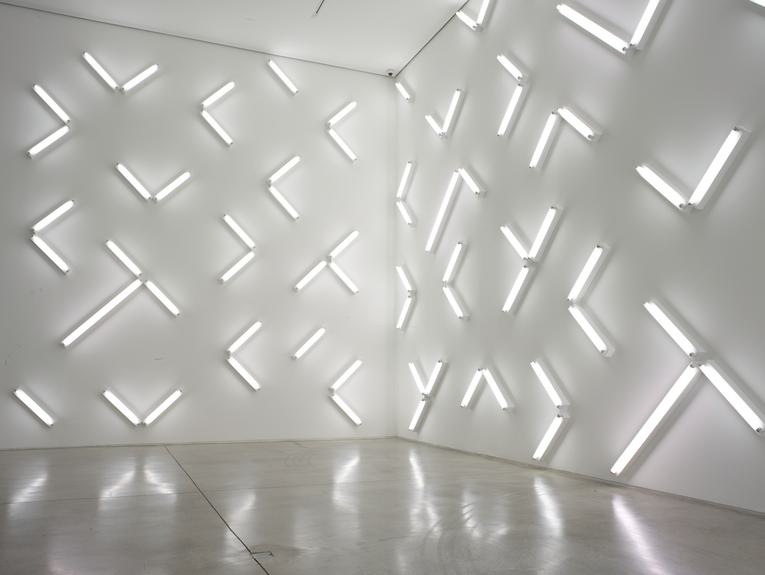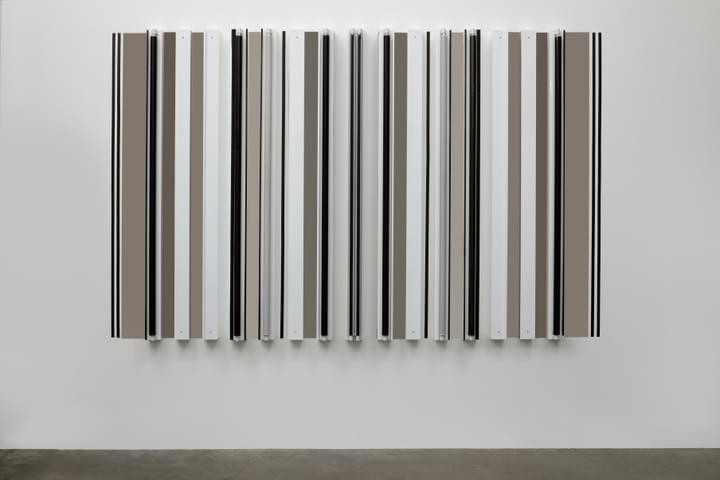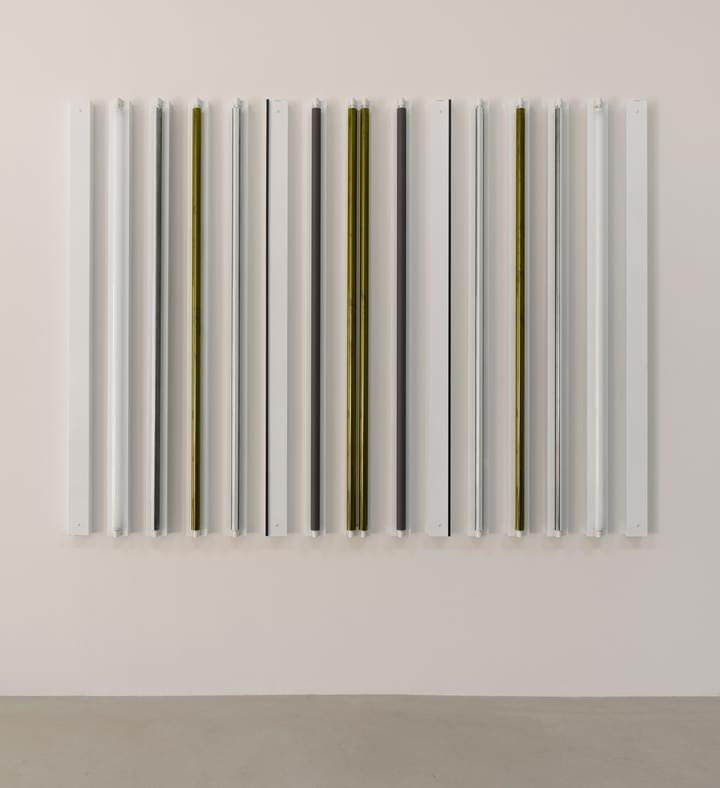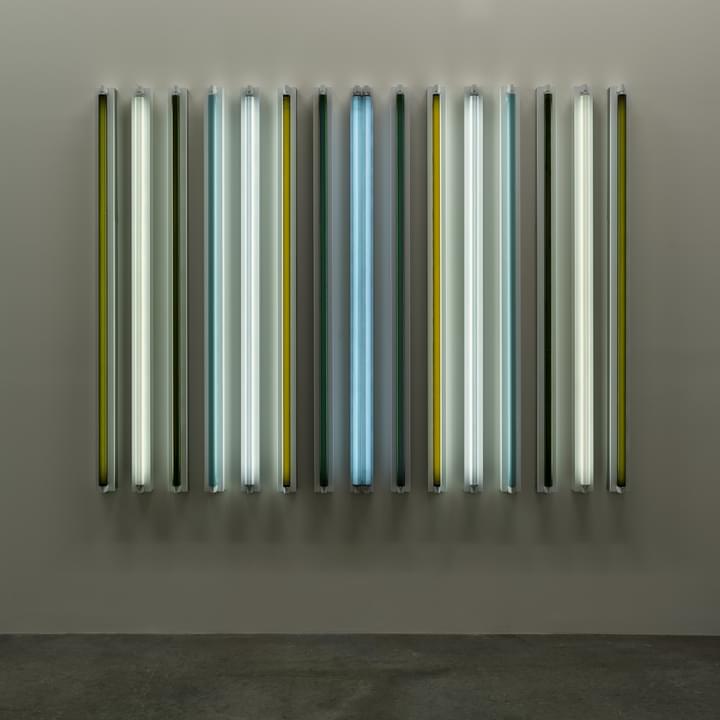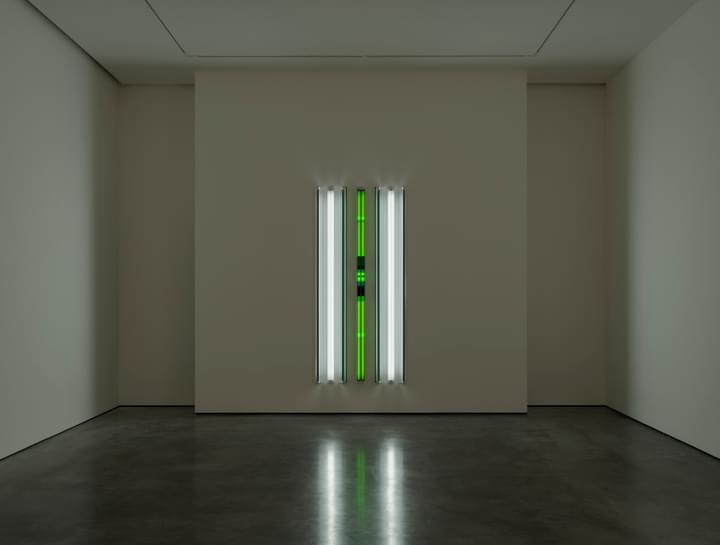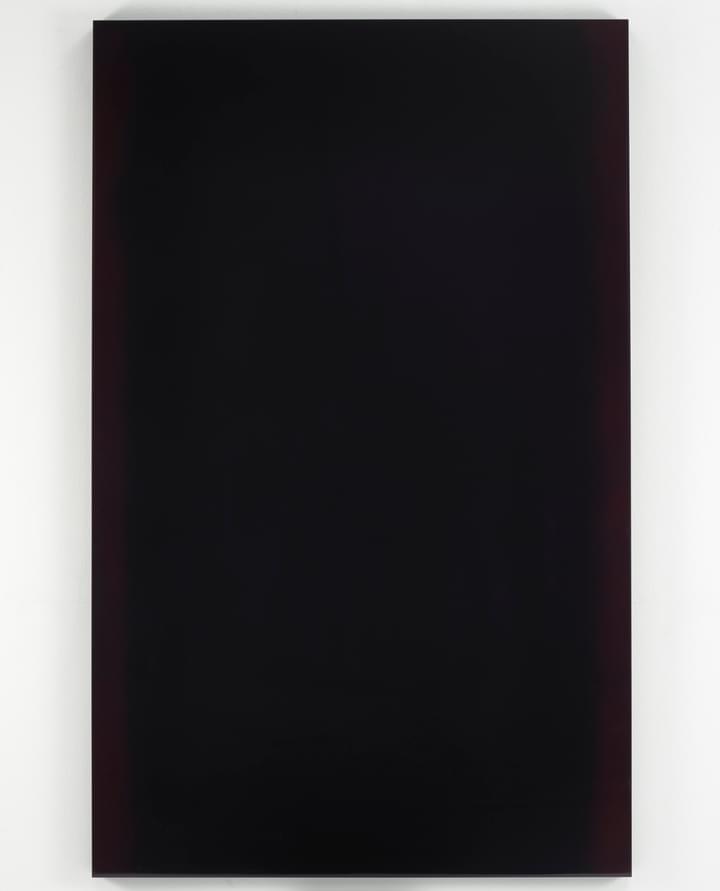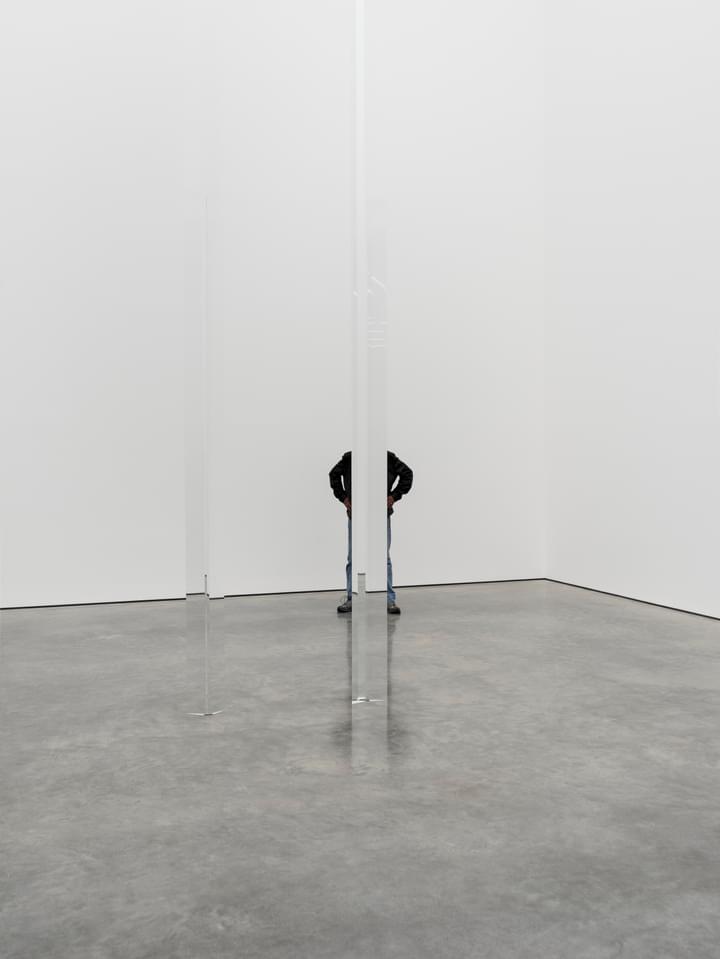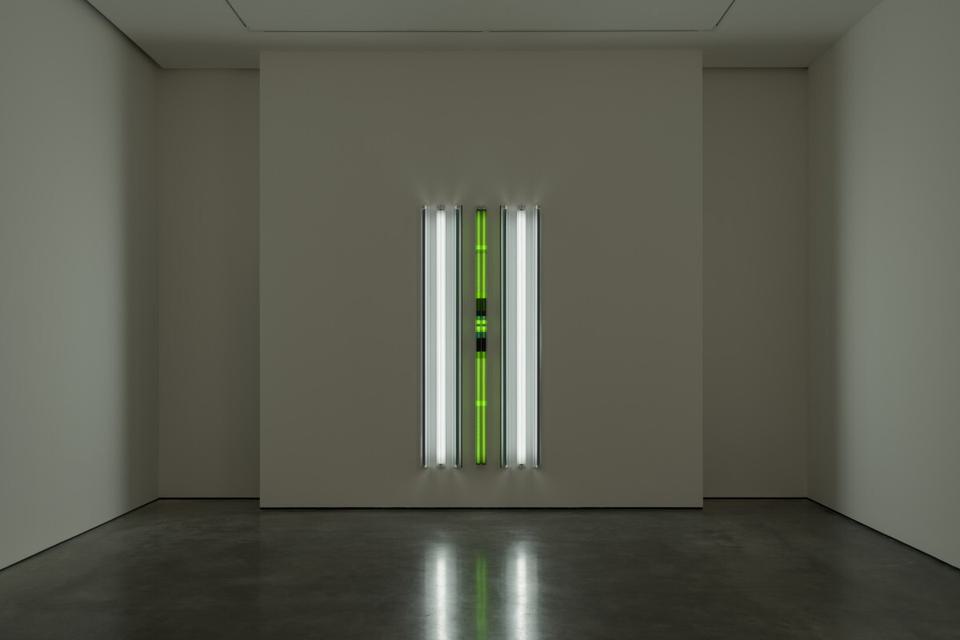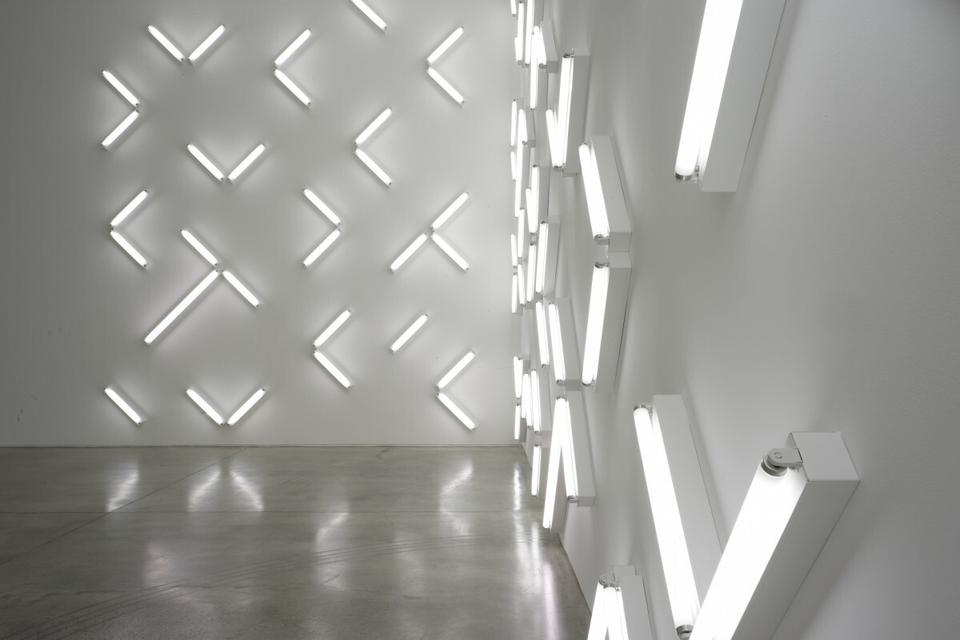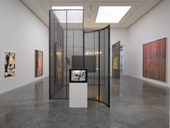Infused with the influence of Malevich, Mondrian, Ad Reinhardt and Josef Albers, and the arguments of Husserl and Merleau-Ponty, the artist (also a prodigious author and lecturer), has written about the ‘triangulation of our consciousness’, inviting a heightened awareness of the interplay between our thoughts, feelings and momentary circumstances. In this, Irwin responds to the Modernist collapse of figure and ground to interrogate the way meaning is structured, and draw attention to what he described as ‘the dynamic of our being phenomenally in the world as an active participant in its becoming real for us’. Scrim, the finely woven fabric often used in theatre as a backdrop, or as window shades, has become Irwin’s hallmark for its ‘defocusing’ effect, appearing opaque until lit from behind. In Square the Room (2007), for example, taut panels of scrim are stretched on wooden frames to create sequential planes, through which graduating colour and shadow are manipulated with coloured gels over fluorescent lights. The artwork’s translucent layers seem to vaporise its very presence, thus focussing the viewer’s attention on the phenomenological experience of moving through the space.
Irwin’s steps towards a ‘phenomenal reduction’ can be traced to his Abstract Expressionist paintings of the late 1950s, awhirl with turbulent marks, which gave way to his experimental hand-held paintings and minimal studies of form and colour. The series of Disc paintings moved Irwin towards an eradication of pictorial space. Wall-mounted discs, formed from aluminium and later plastic, are painted to obscure whether their shape is convex or concave, while artificial lighting casts a rosette of shadow on the wall to obliterate the edge of the painting. ‘The thing to realise is that the reduction was a reduction of imagery to get at physicality,’ he recalled, ‘a reduction of metaphor to get at presence.’
In 1970, Irwin abandoned the studio altogether, and – untethered from two or even three dimensions – started making art in response to a particular site, switching his focus to energy and process rather than material and object. A catalyst to this new approach was his participation, in 1968, in the ground-breaking Art and Technology programme at Los Angeles County Museum, which placed him in dialogue with NASA scientist Ed Wortz and artist James Turrell; as a result of the collaboration, Irwin radically shifted his practice toward non-objective forms. In what he referred to as ‘spatial drawing’, Irwin started employing light, string, tape and scrim to encourage the artwork to sublimate within architecture: taping the floor to connect the walls (Black Line Volume, 1975–76); installing fluorescent lights to articulate a multi-levelled ceiling (Three Plane Triangulation, 1979); suspending a grid of translucent white screens over the internal windows of an atrium (48 Shadow Planes, 1983); or placing reflective panels of single colours over floor and ceiling (Who’s Afraid of Red, Yellow & Blue, 2006–07). Art and situation merge to captivating effect in the installation 1° 2° 3° 4° (1997), which exploits the wraparound windows of the Museum of Contemporary Art San Diego, with their panoramic ocean outlook. Three rectangular apertures are cut into the tinted glazing, highlighting the postcard views, but the actual openings also allow the sea air and natural light to enter the space. The fourth degree of the title refers to time, to the viewer’s ever shifting experience as conditions mingle and change.
While Irwin’s indoor installations aspire to a state of immaculate control, his outdoor projects in public space reckon with the overwhelming flux of the natural landscape. An approach he termed ‘site-generation’ saw him expand the notion of art as inseparable from its environment by honouring the topography, indigenous flora and seasonal characteristics. Irwin observed: ‘You can’t plan the phenomenological in nature… you can only court it… and to know its significance you need to bracket out intellect, for a time, in favour of direct, unmediated experience.’ Laurence Weschler has noted that Irwin’s concept for the lush gardens at the Getty Center, Los Angeles (completed in 2005), is ‘time stretched across a structure’ – an idea that applies equally to Irwin’s landscaping at Dia Beacon, New York, where he also designed the building to ensure its galleries are lit by natural light and that the floorplan presents artworks in a non-chronological, non-hierarchical order (completed in 2003), as to his installation of ‘primal palms’ throughout the campus of Los Angeles County Museum of Art (completed in 2010).
Most recently, at 13,000 square feet, Irwin’s commission for the Chinati Foundation in Marfa, Texas (completed in 2016) operates on a magisterial scale. This permanent freestanding structure is based on the C-shaped footprint of a former military hospital, and uses floor-to-ceiling scrim to conduct the views and the light – to permeate the ethereal in the concrete. Concurrently, Irwin created wall reliefs due to a return to the studio that attends to the artist’s altered physical state. A body of work referred to as ‘unlights’ finds Irwin looking again at fluorescent tube lighting, at a time when the technology is rapidly becoming obsolete. Coloured gels over the electrical fixtures – some on, some off – create dense compositions of vertical stripes. There is an interplay of emitted and refracted light, shadow and reflection; a meditation on what it is to illuminate.
Robert Irwin was born in 1928 in Long Beach, California, and lives and works in La Jolla, California. He has exhibited widely, including solo exhibitions at Kraftwerk Berlin (2021); Pratt Institute School of Architecture, New York (2019); University Art Museum, California State University (2018); Hirshhorn Museum and Sculpture Garden, Washington, DC (2016); Dia Beacon, New York (2015); Wiener Secession, Association of Visual Artists, Vienna (2013); Whitney Museum of American Art, New York (2013); Walker Art Center, Minneapolis (2009); Museum of Contemporary Art, San Diego (2007); Chinati Foundation, Marfa, Texas (2006); Dia Center for the Arts, New York (1998); Musée d’Art Contemporain, Lyon, France (1998); The Museum of Contemporary Art, Los Angeles (1993); Musée d’Art Moderne de la Ville de Paris (1993); and Museo Nacional Centro de Arte Reina Sofía, Madrid (1993). Selected group exhibitions include Hayward Gallery, London (2018); The Museum of Modern Art, New York (2008); Centre Georges Pompidou, Paris (2009); Solomon R. Guggenheim Museum, New York (2004); Whitney Museum of American Art, New York (1999); Louisiana Museum of Modern Art, Humlebaek, Denmark (1997); Kunstmuseum Wolfsburg, Germany (1997); Castello di Rivoli, Turin, Italy (1997); and The Hammer Museum, Los Angeles (1997). Irwin was the first artist to receive the John D. and Catherine T. MacArthur ‘Genius’ Award in 1984.
